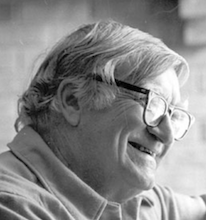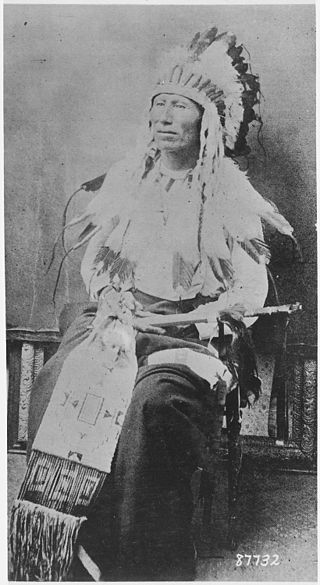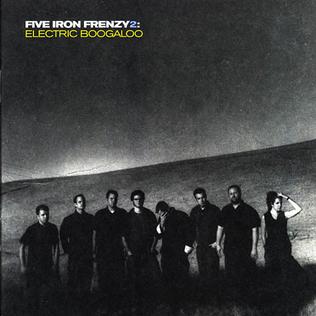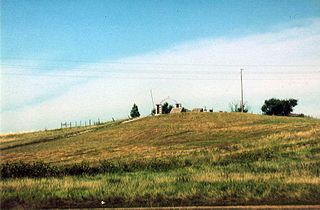See also
- Wounded Knees, an American band
Wounded Knee may refer to

Sitting Bull was a Hunkpapa Lakota leader who led his people during years of resistance against United States government policies. Sitting Bull was killed by Indian agency police on the Standing Rock Indian Reservation during an attempt to arrest him at a time when authorities feared that he would join the Ghost Dance movement.

Dorris Alexander "Dee" Brown was an American novelist, historian, and librarian. His most famous work, Bury My Heart at Wounded Knee (1970), details the history of the United States' westward colonization of the continent between 1830 and 1890 from the point of view of Native Americans.

The Ghost Dance is a ceremony incorporated into numerous Native American belief systems. According to the teachings of the Northern Paiute spiritual leader Wovoka, proper practice of the dance would reunite the living with spirits of the dead, bring the spirits to fight on their behalf, end American Westward expansion, and bring peace, prosperity, and unity to Native American peoples throughout the region.

The Sand Creek massacre was a massacre of Cheyenne and Arapaho people by the U.S. Army in the American Indian Wars that occurred on November 29, 1864, when a 675-man force of the Third Colorado Cavalry under the command of U.S. Volunteers Colonel John Chivington attacked and destroyed a village of Cheyenne and Arapaho people in southeastern Colorado Territory, killing and mutilating an estimated 69 to over 600 Native American people. Chivington claimed 500 to 600 warriors were killed. However, most sources estimate around 150 people were killed, about two-thirds of whom were women and children. The location has been designated the Sand Creek Massacre National Historic Site and is administered by the National Park Service. The massacre is considered part of a series of events known as the Colorado Wars.

The Wounded Knee Massacre, also known as the Battle of Wounded Knee, was the deadliest mass shooting in American history, involving nearly three hundred Lakota people shot and killed by soldiers of the United States Army. The massacre, part of what the U.S. military called the Pine Ridge Campaign, occurred on December 29, 1890, near Wounded Knee Creek on the Lakota Pine Ridge Indian Reservation in South Dakota, following a botched attempt to disarm the Lakota camp. The previous day, a detachment of the U.S. 7th Cavalry Regiment commanded by Major Samuel M. Whitside approached Spotted Elk's band of Miniconjou Lakota and 38 Hunkpapa Lakota near Porcupine Butte and escorted them five miles westward to Wounded Knee Creek, where they made camp. The remainder of the 7th Cavalry Regiment, led by Colonel James W. Forsyth, arrived and surrounded the encampment. The regiment was supported by a battery of four Hotchkiss mountain guns. The Army was catering to the anxiety of settlers who called the conflict the Messiah War and were worried the Ghost Dance signified a potentially dangerous Sioux resurgence. Historian Jeffrey Ostler wrote in 2004, "Wounded Knee was not made up of a series of discrete unconnected events. Instead, from the disarming to the burial of the dead, it consisted of a series of acts held together by an underlying logic of racist domination."

John Milton Chivington was a Methodist pastor, and Mason who served as a colonel in the United States Volunteers during the New Mexico Campaign of the American Civil War. He led a rear action against a Confederate supply train in the Battle of Glorieta Pass, and was then appointed a colonel of cavalry during the Colorado War.

Bury My Heart at Wounded Knee: An Indian History of the American West is a 1970 non-fiction book by American writer Dee Brown that covers the history of Native Americans in the American West in the late nineteenth century. The book expresses details of the history of American expansionism from a point of view that is critical of its effects on the Native Americans. Brown describes Native Americans' displacement through forced relocations and years of warfare waged by the United States federal government. The government's dealings are portrayed as a continuing effort to destroy the culture, religion, and way of life of Native American peoples. Helen Hunt Jackson's 1881 book A Century of Dishonor is often considered a nineteenth-century precursor to Dee Brown's book.

Wovoka, also known as Jack Wilson, was the Paiute religious leader who founded a second episode of the Ghost Dance movement. Wovoka means "cutter" or "wood cutter" in the Northern Paiute language.

Pauline Matthews better known by her stage name Kiki Dee, is an English pop singer. Known for her blue-eyed soul vocals, she was the first female singer from the UK to sign with Motown's Tamla Records.
Redbone is an American rock band formed in Los Angeles, California, in 1969 by brothers Pat and Lolly Vegas. All members during their commercial peak and success were of Mexican American and Native American heritage, which was heavily reflected in their songs, stage costumes, and album art.

Morning Star (1810–1883) was a great chief of the Northern Cheyenne people and headchief of the Notameohmésêhese band on the northern Great Plains during the 19th century. He was noted for his active resistance to westward expansion and the United States federal government. It is due to the courage and determination of Morning Star and other leaders that the Northern Cheyenne still possess a homeland in their traditional country in present-day Montana.

Five Iron Frenzy 2: Electric Boogaloo is the fourth studio album by the band Five Iron Frenzy. It was released November 20, 2001 by Five Minute Walk records.

Thunderheart is a 1992 American Neo-Western mystery film directed by Michael Apted from a screenplay by John Fusco. The film is a loosely based fictional portrayal of events relating to the Wounded Knee incident in 1973, when followers of the American Indian Movement seized the South Dakota town of Wounded Knee in protest against federal government policy regarding Native Americans. Incorporated in the plot is the character of Ray Levoi, played by actor Val Kilmer, as an FBI agent with Sioux heritage investigating a homicide on a Native American reservation. Sam Shepard, Graham Greene, Fred Ward and Sheila Tousey star in principal supporting roles. Also in 1992, Apted had previously directed a documentary surrounding a Native American activist episode involving the murder of FBI agents titled Incident at Oglala. The documentary depicts the indictment of activist Leonard Peltier during a 1975 shootout on the Pine Ridge Indian Reservation.
August Werner Schellenberg was a Canadian actor. He played Randolph in the first three installments of the Free Willy film series (1993–1997) as well as characters in Black Robe (1991), The New World (2005), and dozens of other films and television shows.

Bury My Heart at Wounded Knee is a 2007 American Western historical drama television film adapted from the 1970 book of the same name by Dee Brown. The film was written by Daniel Giat, directed by Yves Simoneau and produced by HBO Films.

The Fort Omaha Guardhouse was built in 1883 to handle Native American, civilian and military prisoners of the Department of the Platte housed at Fort Omaha. Located at 5700 North 30th Street in north Omaha, Nebraska, the Guardhouse was named an Omaha Landmark by the City of Omaha Landmarks Heritage Preservation Commission in 1982. It is also a contributing property to the Fort Omaha Historic District, which is listed on the National Register of Historic Places.

The Wounded Knee National Historic Landmark, known also as Wounded Knee, was the site of the Wounded Knee Massacre of 1890 in South Dakota, United States.

Wake the Sleeper is the 21st studio album by the rock band Uriah Heep, released on 2 June 2008 in Europe and on 26 August 2008 in the United States. The announced September 2007 release was rescheduled as a result of the purchase of Sanctuary Records by Universal Music. This was to allow proper promotion of the album, rather than it be 'lost' during the changeover and, although frustrating for them, was something the band members supported. It is their first studio album since 1998's Sonic Origami. It is also their first album since 1980's Conquest without long-time drummer Lee Kerslake, who had to withdraw from the band due to ill health in 2007, putting an end to the band's longest-lasting lineup which existed for 21 years.

Crow Dog was a Brulé Lakota subchief, born at Horse Stealing Creek, Montana Territory.

The Great Sioux Nation: Sitting in Judgment on America is a book edited by Roxanne Dunbar-Ortiz, "An Oral History of the Sioux Nation and Its Struggle for Sovereignty", that documents the 1974 "Lincoln Treaty Hearing". Testimony produced during that hearing has been cited by the International Indian Treaty Council in advocating for Indigenous sovereignty and treaty rights, efforts which eventually saw the 2007 Declaration on the Rights of Indigenous Peoples.